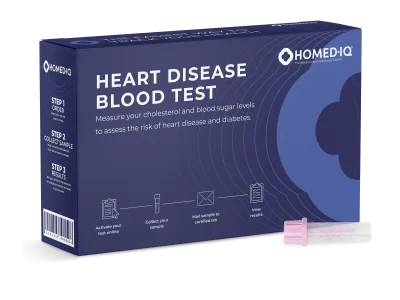Triglycerides are a type of fat found in the blood. After eating, your body converts calories it doesn’t need right away into triglycerides. For cardiovascular health, it is important that there are not too many triglycerides in your blood. Homed-IQ’s home Heart Disease Blood Test can determine your triglyceride levels, as well as LDL, HDL, and blood sugar. Using this test, you can assess whether lifestyle changes are needed to reduce the risk of cardiovascular disease and/or type 2 diabetes.
What are Triglycerides?
Triglycerides are fatty substances that enter the body through food or are produced by the liver. When you eat excess calories (in particular carbohydrates) your liver produces triglycerides. Most fats we eat also contain triglycerides, such as butter, oil, and margarine. Triglycerides are stored as fat on the body for later use.
Why are triglycerides important?
Triglycerides play an important role in the body in several ways. This fatty substance offers protection around your organs, acts as an energy source for the muscles, carries fat-soluble vitamins, and provides insulation to the body.
What is a normal triglyceride level?
There is no specific target value for triglycerides. Triglycerides are considered normal when they are below 1.7 mmol/l (Hartstichting). In this case, the risk of cardiovascular disease is lowered. The following ranges apply:
< 1.5 mmol/l: excellent value
Between 1.5 – 1.7 mmol/l: good value
Between 1.7 – 2.28 mmol/l: sufficient value
Between 2.28 – 3.0 mmol/l: high value
> 3.0 mmol/l: too high of a value
Could your triglycerides level be too high or too low?
It is possible for your blood triglyceride level to be too high. The lower the level the better it is usually for your cardiovascular system. If your triglyceride value is elevated, there are different degrees of risk. If the value is above 3.0 mmol/l, the risk of heart disease and type 2 diabetes is the highest. If your triglycerides are very low (below 0.8 mmol/l), this could indicate other health problems and can increase the risk of stroke (American Academy of Neurology, 2007).
Testing Triglycerides
Testing triglycerides is possible as a part of Homed-IQ’s Heart Disease Blood Test. This home test is simple to perform, using only a finger prick to obtain a blood sample. In addition to determining the triglyceride value, this test includes an analysis of blood sugar and cholesterol levels. After mailing your test, a certified laboratory will examine your sample and a laboratory report will be sent to you.
-

Heart Disease Blood Test
€55,00
When should you test your triglycerides?
It is wise to test triglycerides if there is diabetes. This is because patients with diabetes usually have too high a level of triglycerides. It is of course also possible to perform the test if you suspect, for example because of your lifestyle or complaints, that you may be at risk of developing cardiovascular disease.
The cause of a triglyceride value that is too high
Diabetes is an important cause of elevated triglycerides. Being overweight or having an unhealthy diet also poses a risk for developing high triglycerides, as does drinking too much alcohol. Additionally, there are also genetic factors that can predispose some people to higher triglycerides naturally..
The cause of a low triglyceride value
The reason for low triglycerides can be for several reasons, such as:
- Malnutrition (anorexia)
- Low-fat diet
- Digestive problems
- Hyperthyroidism
Are there any diseases related to elevated triglycerides?
Elevated triglycerides increase the likelihood of developing diabetes, and is also related to liver disease, kidney disease, and thyroid problems.
What if my triglycerides are too high?
Triglycerides that are too high increase the risk of arteriosclerosis, or thickening/hardening of the heart’s blood vessels. However, it is also true that elevation of other biomarkers can also increase your risk of cardiovascular problems, such as LDL cholesterol. That is why an analysis of cholesterol levels also often takes place alongside a triglyceride test.
How can you lower triglycerides?
There are several options to lower triglycerides that are too high. It is first and foremost important to lose weight if you are overweight. If you are not overweight, it is important to exercise more and adjust your diet. For example, by limiting your intake of saturated fats. These fats are mainly found in animal products. That is why it is advisable to alternate foods containing animal products with vegetables, such as legumes. Another way to lower triglycerides is to consume less sugar. Furthermore, alcohol plays a role in overeating, so it is best to limit alcohol consumption as much as possible.
What if my triglycerides are too low?
It is important to find out the cause of a triglyceride level that is too low in order to take appropriate measures. For example, by eating more fats or treating thyroid problems. If your triglycerides are very low, speak to your doctor about potential causes.
What is the difference between cholesterol and triglycerides?
Triglycerides and cholesterol are both fatty substances, but there are some differences between the two. Cholesterol is a waxy, fat-like substance formed by the liver, also known as a lipoprotein. Cholesterol enters the body partially through food and is also produced in the liver. The body needs cholesterol to make bile, and it also serves as a building block for hormones and cells. In contrast, triglycerides are a true fat that is used by the body as an energy source.





